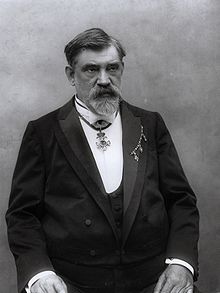František Křižík
This article needs additional citations for verification. (June 2020) |
František Křižík | |
|---|---|
 František Křižík (most likely in 1902) | |
| Born | July 8, 1847 |
| Died | January 22, 1941 (aged 93) |
| Resting place | Vyšehrad cemetery |
| Nationality | Czech |
| Occupation | Engineer, entrepreneur |
| Known for | Arc lamp |
František Křižík (Czech: [ˈfraɲcɪʃɛk ˈkr̝̊ɪʒiːk]; July 8, 1847 – January 22, 1941) was a Czech inventor, electrical engineer, and entrepreneur.
Biography[]
Křižík was born into a poor family in Plánice, located at the time within the Austrian Empire. In spite of his background, Křižík managed in 1866 to study engineering at the Technical University of Prague ČVUT.
Křižík is considered the pioneer of practical electrical engineering and in electrification of Bohemia and Austro-Hungarian empire. At the time he was often compared to Thomas Edison. In 1878 Křižík invented a remotely operated signaling device to protect against collision between trains.[1] Křižík's cores are magnetic solenoids cores shaped so as to insure an approximately uniform pull in different positions in the solenoid.
His first experiments in Plzeň (Pilsen) resulted in the invention in 1880 of the automatic electric arc lamp, the so-called "Plzen Lamp" which was displayed at the International Exposition of Electricity in Paris in 1881. This lamp, with self-adjusting brushes, won the gold medal from among 50 similar devices.[1] Later he successfully defended his patent against Werner Siemens claim to have created it first. His lamps were successfully used in many cities for street lighting. The restored and fully functional patented arc lamp with automated electrode adjustment can be viewed at the Museum of Pilsen. In 1894, he designed an electric musical fountain illuminated by coloured lamps, one of the most popular attractions at the General National Exhibition in Lviv.
In 1895 Křižík built one of first electromobiles in Austrian empire.
In 1884 Křižík set up his own company building city lighting, tramway lines, street cars, power stations, and various electric equipment.
A Prague street and subsequently near subway station were named after František Křižík – Křižíkova.
Electric railway Tábor – Bechyně[]
František Křižík built the first electric railway in the Austro-Hungarian empire in 1903. The track gauge was 1,435 mm (4 ft 8+1⁄2 in) standard gauge. The maximum speed was 50 km/h (31 mph).
Railroad Stations: Tábor – Horky u Tábora – Slapy – Libějice – Malšice – Čenkov u Malšic – Třebelice – Všechlapy – Bechyňská Smoleč – Sudoměřice u Bechyně – Bežerovice – – Bechyně
Legacy[]
The main belt asteroid 5719 Křižík was named in his honor.[2]
References[]
- ^ Jump up to: a b František Křižík
- ^ "JPL Small-Body Database Browser". NASA. Retrieved 2008-05-03.
External links[]
| Wikimedia Commons has media related to František Křižík. |
- Biography (in Czech)
- František Křižík, has diagram of his differential arc lamp
- 1847 births
- 1941 deaths
- People from Plánice
- Czech engineers
- Czech inventors
- 20th-century Czech businesspeople
- Czech Technical University in Prague alumni
- 19th-century Czech businesspeople
- European business biography stubs
- Czech people stubs